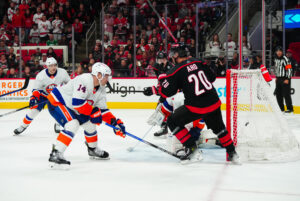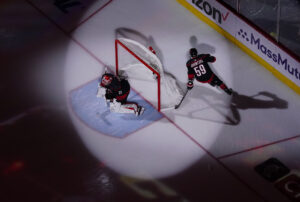NHL player development seems to always result in more questions than answers. How likely is it for a top pick to pan out? What makes a player a “steal”? Last Word On Hockey will be starting a new series on how to properly develop prospects from all different spots throughout the draft. This week’s piece involves draft picks in the back-half of the first round and how they were used early in their careers.
NHL Player Development Of First-Round Picks
In the span of 2005 through 2015, there were 84 total selections made between 16th overall and 30th overall on forwards playing in North America. Looking at all 84 forwards, they were split into different categories. Those categories were “Forwards Deemed NHL-Ready and Brought In Immediately When Ready,” “Forwards Near NHL-Ready and Brought In Immediately When Near-Ready,” “Forwards Rushed Slightly,” “Forwards Rushed,” “Forwards Forced,” “A Little Patience,” “Patience,” and “Too Much Patience.”
There were 13 forwards who fell into the third category on the list. Of those 13 players, four made their NHL impacts in their DY+4 season. Those four players are Alex Tuch, Nikita Scherbak, Jordan Schroeder, and Ryan Hartman. Today, we will look at Schroeder and Hartman.
NHL Player Development Of Jordan Schroeder
Schroeder, drafted 22nd overall in the 2009 draft by the Vancouver Canucks, came out of the University of Minnesota. Before playing in the NCAA, he played his DY-1 season with the US National Team Development Program. With them, he scored 21 goals and 23 assists for 44 points in 41 games, for 1.073 points per game. That ranked 25th among the aforementioned 84 forwards in DY-1 production. Then, as a freshman in Minnesota, he scored 13 goals and 32 assists for 45 points in 35 games, for 1.286 points per game. That ranked 29th among the 84 forwards in DY production. After being drafted, Schroeder would play one more NCAA season, then two AHL seasons, before making an NHL impact.
Forward Jordan Schroeder has been added to the 2016 U.S. Men’s National Team: https://t.co/XevrEgrxMg #2016MWC pic.twitter.com/cMptawLADl
— USA Hockey (@usahockey) April 27, 2016
In his sophomore season with Minnesota, Schroeder scored nine goals and 19 assists for 28 points in 37 games, for 0.757 points per game. That ranked 61st out of the 82 forwards still outside the NHL in DY+1 production. The following season, in the AHL, Schroeder scored 10 goals and 18 assists for 28 points in 61 games, for 0.459 points per game. That ranked 67th out of the 70 forwards still outside the NHL in DY+2 production. Schroeder followed that up with 21 goals and 23 assists for 44 points in 76 AHL games, for 0.579 points per game. That ranked 21st out of the 46 forwards still outside the NHL in DY+3 production. He would get his NHL shot the following season.
How Was Schroeder Used?
In his first crack at the NHL, he would split between the NHL and AHL. In the AHL, he scored 12 goals and 21 assists for 33 points in 42 games. Meanwhile, in the NHL, he would average 13:43 time on ice per game across the 31 games he played. With that role, Schroeder scored three goals and six assists for nine points. His point production as a rookie was modest, as was his analytics. Schroeder’s even-strength offence goals above replacement (EVO) was an okay 1.3. Meanwhile, his even-strength defence goals above replacement (EVD) was better than the average rookie, but still not great, at -0.3. With a small role and modest production, his wins above replacement (WAR) and goals above replacement (GAR), were both at 0.
After an okay rookie season, he would again split between the AHL and NHL. At the AHL level, he scored just one assist in two games. In the NHL, he scored three goals and six points across 25 games, while averaging 12:01 per game. His analytics this time were weird, but better. While his EVO (-1.1) fell below replacement level, his EVD (0.8) improved. With better defensive impacts and some special teams value, Schroeder would record a WAR (0.1) and GAR (0.6) that was slightly better than the year prior.
New Team, Same NHL Player Development
Year three would be a near-exact season of the year prior. After joining the Minnesota Wild in the offseason, it would make no difference to his deployment. He again split between the AHL and NHL. This time, he played 35 AHL games, scoring 10 goals and 18 assists for 28 points. Then, in the NHL, he played another 25 games, this time averaging 10:51. That’s a continual regression in ice time since year one. In that small role, he scored three goals and eight points. His analytics were the best of his career, by far. His EVO (2.0) was much improved, as was his EVD (2.2). With that big improvement, his WAR (0.8) and GAR (4.4) were decent.
Following that third season, in 2014-15, he would play parts of the next three seasons in the NHL. Two of those seasons were with Minnesota, where he scored a total of eight goals and nine assists for 17 points in 63 games. In his last NHL season, in 2017-18, he joined the Columbus Blue Jackets. With them, he played 21 games and scored two points. The following year, he played only in the AHL, with 45 points in 62 games. In 2019-20, Schroeder would leave to play in the KHL for two seasons, scoring 37 goals and 39 assists for 76 points in 110 games. Next season, he is slated to play in the Swiss National League.
Schroeder’s NHL player development did not go well. Though there may be more factors than just playing time, he never got a fair shot. Despite solid underlying numbers in year three, he would not be given a bigger role. His career eventually fizzled out before heading overseas.
NHL Player Development Of Ryan Hartman
Hartman, drafted 30th overall in the 2013 draft by the Chicago Blackhawks, came out of the OHL’s Plymouth Whalers organization. Before joining them, however, he would play with the US National Team Development Program in his DY-1 season. With them, he scored 16 goals and 25 assists for 41 points in 59 games, for 0.695 points per game. That ranked 47th out of 84 forwards in DY-1 production. In the OHL, he scored 23 goals and 37 assists for 60 points in 56 games, for 1.071 points per game. That ranked 48th out of the 84 forwards in DY production. After being drafted, Hartman would play one more OHL season and two AHL seasons before making his NHL impact.
In his second OHL season, Hartman scored 25 goals and 28 assists for 53 points in 52 games, for 1.019 points per game. That ranked 46th out of the 82 forwards still outside the NHL in DY+1 production. Following that season, he would head to the AHL, scoring 13 goals and 24 assists for 37 points in 69 games, for 0.536 points per game. That ranked 62nd out of the 70 forwards still outside the NHL in DY+2 production. In his second AHL season, Hartman scored 15 goals and 20 assists for 35 points in 61 games, for 0.574 points per game. That ranked 22nd out of the 46 forwards still outside the NHL in DY+3 production. After that season, he would get his NHL shot.
How Was Hartman Used
In his first NHL season, Hartman would play 76 games and average 12:46 per game. In that role, he scored 19 goals and 12 assists for 31 points. His analytics were extremely good for a rookie. His EVO (5.7) was really solid, but his EVD (2.2) is rare to reach for a rookie. With that strong even-strength impact, Hartman recorded a WAR (1.7) and GAR (8.9) that is hard to achieve for anyone, let alone a rookie.
The following season, he would get dealt mid-way through the season to the Nashville Predators. In total, he played 78 games and averaged 13:04 per game between the two teams. With that role, he scored 11 goals and 20 assists for 31 points. While his production regressed, it was due to the move and his struggles with Nashville. His analytics would fall as well, but they were still strong. His EVO (2.4) and his EVD (0.3) were not nearly as impressive, but still above replacement level. With that, his WAR (0.8) and GAR (4.2) were still decent.
Year Three Has Another Trade, Leading To NHL Player Development Set-Back
In year three, Hartman would again get traded mid-way through the season. This time, he was dealt to the Philadelphia Flyers. In total, he played 83 games and averaged 13:07 per game. With that role, he scored 12 goals and 14 assists for 26 points, another step back in production. While his EVO (5.6) would improve back to rookie year level, his EVD (-3.3) was really poor. With the poor defensive impact, Hartman would see his WAR (0.4) and GAR (2.2) fall quite a bit.
After that third season, in 2018-19, Hartman would join his fourth team in four years with the Minnesota Wild. In his first two seasons with his newest team, he scored 42 points in 120 games. That is similar production to his year two and three seasons. But, last season with the Wild, Hartman would break-out. He scored 34 goals and 31 assists for 65 points in 82 games, showcasing the potential he displayed in year one. Next season, he is expected to perform at that same level once again. Hartman’s NHL player development was not great, more due to the trades than his actual deployment. But now, with some stability in Minnesota, he has adjusted and regained his rookie year traction.
Junior league stats via Elite Prospects, NHL stats via Hockey Reference, NHL analytics via Evolving Hockey






